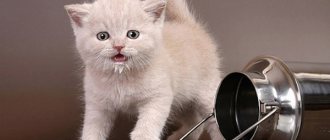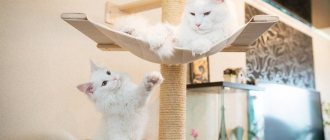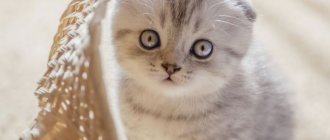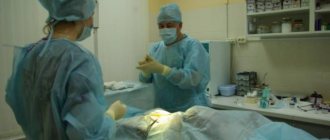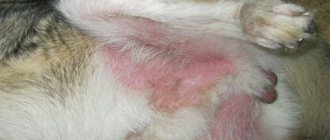If there is a new addition to your cat family, get ready for sleepless nights. And don’t even try to deceive yourself by the temporary helplessness of babies and their dependence on their mother.
Pretty soon, the fluffballs will stop crawling and confidently stand on all fours in search of adventure. At this point, you will have to answer for their safety. But knowing what time kittens begin to walk, you can protect them from possible problems, injuries and deviations.
Content
1. From newborn to full-fledged member of cat society
– Eye opening
- Teething
– Standing up and walking
– First taste of adult food
– When to give the baby to new owners?
2. How does a cat’s locomotor system develop?
3. When kittens start walking instead of crawling – what should you pay attention to?
4. Possible problems and deviations
5. Baby safety and care
When their eyes open
The process of eye opening in cubs of different breeds begins on the 5-9th day of life. Delays may occur if the baby was born weakened or the mother is not fed correctly.
Be sure to read:
At what age can you take a kitten from a cat, when can you give away kittens?
Experienced breeders know breed differences. Beginning cat lovers should know that girls' eyes open earlier. Babies of long-haired breeds mature later than short-haired ones.
If the baby is 2 weeks old and its eyes have not opened, it is recommended to moisten them with strong tea or diluted boric acid and try to move them apart. In case of failure, contact an experienced felinologist or veterinarian.
From newborn to full member of feline society
Newborns weigh only 100 g. For the first 10 days they rely completely on their mother, as their senses are just beginning to develop.
Kittens are born blind, deaf and toothless. Their only reference point in space is their developed sense of smell. With its help, they can easily find mother's nipples located within 60 cm.
It takes a lot of time to develop into a full-fledged member of cat society. Each stage of growing up is unique and full of challenges, so try to give your pets all the support they need.
Eye opening
The eyes open 10-14 days after birth. The exact time depends on gender and coat length. Girls with short hair always mature earlier than boys with long hair.
Please note that all newborns have blue irises. With age, its color may change.
Teething
Milk teeth erupt on days 21-28, and after another 2 months their place is gradually taken by molars. By this point, the pets have already left the “nest”, and all poorly lying objects suffer from their new teeth.
Standing up and walking
Along with vision comes hearing. Thanks to new sensations, the world around us becomes more and more interesting.
Out of curiosity, kittens crawling on their tummy begin to make their first attempts to stand on their paws. At 3 weeks of life, they are already trying to walk, but they do it very clumsily and often fall. Their coordination improves by about 1 month.
First taste of adult food
Complementary foods are given at 1-1.5 months, when the cat’s breast milk supply begins to decrease. All food served is thoroughly boiled and crushed, achieving a liquid consistency. Solid foods are introduced into the diet only after all baby teeth have appeared.
When to give the baby to new owners?
Acquaintance with a new family should be done at 2.5-3 months. By this point, the diet of kittens is no longer different from that of an adult, so they cope much more easily with separation from their mother. This age is also optimal for vaccinations that provide immunity against the most common viruses.
New owners will have to go through 2 more stages with their mustachioed pets on the way to growing up: the first molt and puberty. After this, the active growth phase ends, and the animals are equated to adults.
When can you take a kitten from a cat and give it to a new owner?
Babies are taken away from the cat and begin to be distributed at 6 or 8 weeks, when they begin to drink less breast milk and learn to eat on their own and use the litter box. At this age, it is easier for them to adapt to a new home, although this will be serious stress for kids.
The owner-breeder gives the babies away much later - by the third month of life. This is due to the preparation of documents for babies, as well as the long period of vaccination.
As soon as the eyes of small squeaking lumps begin to open, their development occurs several times faster. Therefore, it is important to monitor kittens during this period of life, so as not to miss the moment when they turn into elegant and graceful creatures.
How does a cat's locomotor system develop?
The musculoskeletal system consists of bones, muscles and joints. Only the hind legs are a direct continuation of the cat's skeleton. The forelimbs do not have a solid joint. They are connected to the skeleton by elastic and strong tendons. They provide smooth landings from great heights and a silent gait.
The hind legs are always stronger than the front legs, since they have to take a much larger load. They serve as support and help push off while running and jumping.
Full development of the body takes about a year, but motor function becomes available to babies already at 1 month of life. During this time they go through the following stages:
- Moving by crawling. In the first 5 days, pets move only in the direction of their mother to eat. By day 10, they begin to use their front legs. Pushing off the floor with them, the kittens ride more and more confidently on their bellies, like swimmers.
- Standing on your front paws. The first attempts are made in 1.5-2 weeks. By the end of this stage, the hind limbs also become stronger, expanding the available capabilities.
- First steps on 4 paws. When making their first movements, babies are guided by their mother. Repeating after her, they sway strongly and often fall out of the blue, but with each attempt they become closer to the goal.
- Gradual improvement of coordination to the level of adult animals. From the 3rd week, animals try to master not only walking, but also running and jumping. During the game, they can fight each other or hunt for their own tail.
The movements of whiskered pets at 1 month are very different from the timid attempts to learn to walk in the very first stages. By this age, small pets no longer fall over while running, actively play with each other and make confident jumps on low surfaces.
Fourth week of kitten life
Not even a month has passed since the day your kittens were born, and the most important stage in their lives has already begun, which scientists call the imprinting and socialization phase. Or, as popular wisdom says: “Teach a child while he’s laying across the bench, but he’s stretched out to his full length—you won’t teach him.” All the impressions that the kitten encounters during this period are of particular importance for him, since they determine not only the immediate reaction, but also all the further behavior of the animal. Everything that a kitten learns is forever etched into its consciousness and leaves indelible marks that will subsequently play a decisive role in the formation of its character. Conversely, what a kitten is not accustomed to before the 9th week of life may cause him difficulties later
It is important that kittens do not grow up isolated from people. Now they need to be picked up and stroked more often
Even at this point, it becomes clear how much the character of one baby can differ from the character of another. Some kittens meow pitifully, others nestle comfortably on your lap, and still others, not at all embarrassed, begin to play with the strings of your clothes. But if the baby did not know human affection at all, he will remain distrustful, withdrawn and timid for the rest of his life.
Kittens, who just recently had difficulty moving their paws, are now beginning to discover completely new abilities. Sometimes the kitten itself cannot understand how it suddenly managed to climb onto the sofa on its own, without anyone’s help, and does not dare to go back down. During this period, kittens not only learn to coordinate their movements, but also discover that they, it turns out, have teeth and claws that can be used in a variety of situations: when you want to get to mother’s milk faster than others, play, rummage in the sawdust, where... either climb up or start a fight. Possessing such a “weapon”, kids are already able to stand up for themselves.
Every day, the kittens' teeth and claws become stronger and sharper, so the mother cat often has a hard time when feeding. Kittens are biting and scratching her more and more often, due to
to which she angrily pushes her kids away and leaves them much earlier than before. Now the cat decides for itself when to feed its babies and no longer rushes to them on demand. By the end of the 4th week, the kittens' milk teeth have fully erupted, and from now on they can be gradually accustomed to new foods. The sense of taste in kittens begins to form as early as the 3rd week of life, and by the end of the fourth it has already managed to fully develop. During this period, kittens are still very clumsy, and their attempts to perform this or that action often look quite funny. They play funny, have difficulty mastering the complex procedure of licking and, swaying on unsteady legs, rush to rush into the thick of the fight or pounce on the toy mouse that their mother brings them. Now that the kittens can finally see clearly, eat solid food and use the toilet, their development is progressing by leaps and bounds.
When kittens start walking instead of crawling, what should you pay attention to?
The development of each animal is individual, so there is no need to rush things. Your main tasks are surveillance and security.
Small pets can start walking at completely different times. It all depends on the state of their body at the time of birth and the quality of nutrition.
If there are weakened kittens in the litter, help them find nipples or transfer them to artificial feeding. It is more difficult for such animals to compete with hungry brothers, so they often lag behind in development.
Track your cat's motor development at each stage. Pay special attention to week 3. If, when trying to stand on its legs, the baby squeaks loudly or limps heavily, take him to the vet.
The same should be done if you continue to crawl. Such symptoms may indicate congenital or acquired pathologies.
The nuances of caring for a kitten
The kitten is the same child. If the apartment creates safe conditions for him to run around and play pranks, development will proceed without problems. However, you should still carefully monitor how the kitten moves. Is he limping? Is he lagging behind in development? Full mobility and grace are extremely important for felines.
As soon as the kitten begins to show curiosity about its surroundings, you need to remove everything dangerous from its path. A baby can get into trouble anywhere: get stuck between pieces of furniture, pull a tablecloth and drop a dish, catch its claws on the carpet and dislocate a paw.
If any limb fails the cat when running around or causes pain in the pet, which will be noticeable in the baby’s behavior, you need to visit a veterinarian and find out what’s wrong. The kitten is very fragile, and sometimes the owner himself, and especially young children, can harm the baby. Any rough or sudden movement can break a weak bone in the paw and cause suffering for the baby. You should handle your pet very carefully.
Under no circumstances should you pull the paws or push the little prankster with your foot. If your pet needs to be transported somewhere, you should constantly hold it in your arms, since any shaking during transportation can cause a broken leg. At home, it is better not to sit your pet on the sofa. If the cat decides to jump from there, injuries are inevitable.
Possible problems and deviations
Treatment of the problem must begin immediately after its appearance. Otherwise, the pet may remain disabled.
Pain and weakness of the limbs are characteristic of the following pathologies:
- hip dysplasia, expressed in abnormal tissue development;
- liver diseases complicated by neurological disorders;
- acute intoxication;
- primary (arthritis) and secondary (trauma) dysfunctions of the musculoskeletal system;
- rickets, characterized by softening of the bones;
- malignant neoplasms.
The risk group includes Maine Coons. Due to active growth and large dimensions, 23% of representatives of this breed suffer from dysplasia. Their weight gain outpaces the development of joints, so the body simply cannot cope with the load placed on it. Also, this pathology can be inherited, and its presence must be recorded in the pedigree.
Please note that an animal suspected of being injured should not be transported. Shaking on the road can aggravate his condition, so it is better to call a doctor at home.
Acts of urination and defecation at different ages
The health of the animal depends on the number of times your pet goes to the toilet. In order not to miss pathologies or any diseases, the owner should know how often cats of different ages go to the toilet, and what to do if the kitten does not defecate for a long time.
It's easier to litter train a small kitten
Newborn kittens
In the first three weeks after the kittens are born, the mother cat helps the newborns with going to the toilet. By licking them, she not only cleanses her children of dirt and foreign odors, but also stimulates blood circulation in the digestive organs. This massage helps the baby get rid of gases and have a bowel movement.
Note! If the mother cat cannot care for the kitten, then taking care of it falls on the shoulders of the owners. Therefore, the owner should stimulate bowel movements by stroking every 2 hours before the pet begins to eat and after
When the baby refuses to go to the toilet in a big way for several days, you can do some manipulations. They will help eliminate gas from a bloated tummy. To do this, take a soft brush or cotton wool soaked in warm water and gently begin to massage the kitten’s belly in a clockwise direction.
Month old kittens
When a small pet has reached the age of 3 weeks, its intestines are already formed, have beneficial microflora and are ready to accept more adult food. During this period, the kitten still feeds on mother's milk, but with the gradual introduction of complementary foods in the form of creamy or liquid food.
At the age of three weeks, the kitten has formed a reflex of urination and defecation, so the pet begins to go to the toilet on its own about 3-6 times every day. Normally, a kitten’s stool should have a mushy appearance, be thick and uniform, without any impurities (undigested pieces of food, mucus). The animal itself must be vigorous.
Important! An alarm bell is the presence of too dry or liquid feces in a kitten. If your pet does not go to the toilet regularly for more than 3-4 days, it is worth reviewing its diet
Abdominal massage and microenemas will help you defecate.
If your pet does not go to the toilet regularly for more than 3-4 days, it is worth reviewing its diet. Abdominal massage and microenemas will help you defecate.
Massaging the kitten's tummy in a circular motion to improve bowel movements
Despite the fact that small cats at the age of one month can defecate on their own, their mother helps them with this process for some time.
Adult kittens
A young cat switches to adult food at the age of one to three months. At this time, his feces are already more solid. The frequency of trips to the toilet, the consistency of excrement - all this depends on the animal’s diet.
Note! If he is fed a high fiber diet, the number of bowel movements will increase compared to if he was fed a high protein diet. An already grown-up pet should go to the toilet a lot every day, and its waste products should not contain impurities of mucus, blood or undigested pieces of food
The owner should be alerted when kittens begin to poop liquid feces
An already grown-up pet should go to the toilet a lot every day, and its waste products should not contain admixtures of mucus, blood or undigested pieces of food. The owner should be alerted when kittens begin to poop liquid feces.
The impossible is possible: a kitten learns to walk despite the verdict
The kitten, who, after a severe spinal injury, was predicted by veterinarians to live no more than six months, not only survived contrary to predictions, but is still learning to walk and has become a real Instagram star. A powerful thirst for life, serious guardianship and the most unexpected coincidence of circumstances came into play.
The kitten Dodoshka, a purebred Briton, was needed and loved for only a short time in his first home. An accident happened: the baby fell under a folding sofa and received a terrible spinal injury. The veterinarians’ diagnosis sounded like a death sentence: the animal was disabled, the spinal cord was broken, and it was almost impossible to restore the mobility of the hind legs. The owners got scared and took the simplest route - they took him to sleep. But that did not happen.
At first, Dodoshka – as a “non-standard patient” – had to become a test subject in the hands of random veterinarians and undergo a real survival experiment. The veterinary clinic doctors were interested in studying the complex case, but since the recovery rate after such spinal surgeries tended to zero, they did not put a fixation plate on the back - they simply cut the kitten open, studied it and sewed it up. Moreover, during this stupid procedure, the bladder was torn. Another operation was needed. In this situation, the ownerless baby should not have survived. However, a month passed, and Dodoshkin’s incredible luck began. First, the little suicide bomber caught the eye of a volunteer girl who came to the reception with her animal. She told her friend, the president of the ZEUS Foundation, Linda Sabantseva, about the unfortunate man. So the kitten ended up at Linda’s house in the company of dozens of other dogs and cats. Three difficult months passed there.
“Your heart always clenches when you realize that disabled people, especially those with spinal cords, have almost no chance,” says Linda. — The owners don’t want to spend money. Doctors believe that it is better to buy a new animal. Even this clinic only took the kitten as an experiment to raise the level of their surgeon. Sad, sad and painful. It hurts for them, because we have no right to take anyone’s life. I often hear, “Your animal needs to be put down,” and I always struggle. And I have many victories. Animals do not experience feelings of inferiority. They are also struggling. And through joint efforts, often, despite doctors’ forecasts, they live and make us happy. This was the case with Dodoshka. I decided: we live and enjoy life as much as possible. And happiness happened. Everyone has their own destiny. Despite the diagnosis, the kitten was lucky to get to the people who helped him.”
One day, Tatyana, a volunteer at several shelters, came to visit Linda and simply could not let Dodoshka off her hands. The baby went to his new family. It’s quite difficult to believe this: Dodoshkin’s future owners already had their own cat, two adult children and their own quiet, prosperous life.
“At first we were talking about temporary foster care,” explains Linda, “because the care was extremely difficult: we had to watch our diet, hygiene, massage and let us move more. At that time, I already had more than 50 animals at home and it was difficult to provide such conditions. The decision in Tatyana's favor was swift. I understood that she would no longer torture the kitten, I understood that she would hear me.”
“This is not heroism at all,” notes Tatyana, Dodoshka’s owner, in turn. – I just saw this kitten and realized that this was my animal. No advice works here. Just a feeling. Like with a child. Of course, my husband and I were shocked: we didn’t understand how it was possible to do this to an animal. We are people. People are always to blame for everything, human carelessness, carelessness: they didn’t pay attention somewhere, didn’t close the window... No one is immune from this. Moreover, if we break our leg, we are not thrown into the trash heap or taken to be euthanized. So how can you do this to animals?! I understood that the first time would be difficult. Dodoshka had bedsores, in some places a complete mess and no skin. At first the whole apartment was filled with the smells of a sick child. Sometimes there was even a gag reflex when treating wounds, but over time it goes away. It was just necessary to treat him urgently.”
Moreover, the treatment was not in a veterinary clinic and not under the guidance of doctors who only talked about euthanasia; everything had to be done independently. True, with the sensitive support of Linda. Gradually, Dodoshka got used to diapers and began to crawl freely around the apartment. All this was possible only with complete sanitation - at least washing the floors three times a day. Therapeutic drugs were selected as carefully as possible. “At first, we tried a lot of things, but the one that helped us the most was the Soviet drug streptocide,” says Tatyana. — Gradually, a first aid kit was formed, our gentleman’s set - miramistin, napkins, diapers, nappies. And all the manipulations became automatic: she took it off, wiped it, shushed it, dried it, combed it, pressed the diaper, put on a new diaper. After two weeks everything became very simple. I always understood that difficulties are temporary.”
At this time, one thing was required from Dodoshka - angelic patience. The baby's shock was not weak and not only painful - he had to go through a long process of adaptation to the new home and get used to the idea that there was no longer any danger for him here. For the first week, the kitten barely moved; every movement was made at the cost of incredible effort. It took weeks of training and mental stabilization. Meanwhile, as the wounds healed, it was necessary to switch to a new therapy regimen. “Cats have a property: if the central nervous system is damaged, then peripheral connections are activated,” explains Tatyana. “It became clear: our salvation is massage, movement and swimming.”
Daily water procedures, proven therapy and the owner’s care stirred up in Dodoshka the desire to enjoy life, no matter what. A couple of months passed until the kitten was able to sit and move actively. Now there was no stopping him, although he, of course, did not run, but only walked briskly on his front legs. On the back ones, meanwhile, fashionable yellow wristbands appeared, which protected against chafing.
Tatyana recorded the entire recovery process - difficult, but progressive - and posted photos on Instagram and Facebook. Not so that they feel sorry and support, but so that they understand: this is also possible, and this does not at all mean forgetting about yourself and dooming the animal to suffering. “Any life is priceless,” Tatyana is convinced. — It is wrong to look at disabled animals as defective: they know how to enjoy life at the level of instinct! They offered me money for Dodoshka, but I said: “Thank you, this is my cat, I can handle it.” I believe that support is needed when there is no self-confidence, confidence that you are doing everything right. Over time it comes, and then there are no problems. There is no need to prove anything to anyone, or try to jump over any standards. You just need to understand that this is your path. And walk along it. To do this, it is enough to respect yourself. As for helping, look how many homeless dogs there are, how many cats need a chance to live. Help them. But it’s difficult to help people in the abstract - it’s always easier to help a specific animal from a photograph.”
And so it happened. Help did come to Dodoshka - completely unexpected, but very necessary. Through the World Wide Web, news about the unique kitten first reached compassionate students from London, and from them to employees of the American company K-9 Orthotics & Prosthetics Inc., which specializes in vehicles for disabled animals. And soon Dodoshka was sent a gift - a personal cart: comfortable, lightweight, and most importantly, giving an additional scope of action.
On December 12, Dodoshka turned one year old. Now he is unrecognizable as a frightened baby who could hardly roll over on his side. His Instagram profile has more than three thousand subscribers, and there are even two small but very real clips about him. However, this, of course, does not cancel all the same regular and vital procedures.
To the question - “Where does strength come from?” – Tatyana answers like this: “Out of nowhere.” They just are. Plus, of course, Dodoshka’s gratitude gives strength. When you look into his eyes and read such immeasurable gratitude in them, you understand that you really gave him a chance. And it's very nice. You begin to respect yourself for not being scared.”
Dodoshka is not the only one whom Tatyana has helped over the past year. Thanks to her volunteer work, more than a dozen dogs and cats have found homes. In addition to Dodoshkina’s Instagram page, Tatyana moderates the “I want to go home” community on Facebook. I want to get home”, where she publishes photographs of her new charges almost every day. Among them, for example, are the handsome dog Nelson, rescued from a municipal shelter, the Rottweiler Rodi, abandoned by her owner, and the terribly colorful cat Banker (or simply Bonya). Each of them deserves attention. Especially on New Year's Eve.
cat Dodoshka
How to solve the problem of estrus in a cat
When pets reach puberty, the owner must decide whether his cat will participate in procreation. If the owner is ready to start breeding kittens, then it is necessary to prepare for the “wedding” even before the onset of the next heat.
If the decision is made to prevent pregnancy, then it is best to sterilize the cat. This will save the owners from regular songs that last a week, and will protect the cat from broken hopes and regular exhaustion due to falling in love.
Sometimes you have to resort to medications. The use of medications is only a temporary solution. Constantly suppressing your cat's instincts with medications can be harmful to your pet. There are two types of “helper pills”:
- Preparations based on herbal infusions. They do not harm the cat's body and are considered safe.
- Medicines. You should not often resort to such radical methods. Regular use, for example, of Suprastin, can cause poisoning, and long-term use of it provokes the occurrence of cancer.
When letting a kitten into your home, you need to familiarize yourself with the nuances that you will have to face when the baby reaches adulthood, namely when cats begin to walk.
The problem of estrus in cats requires patience from the owner. During the mating season, a cat is capable of tormenting not only herself, but also those around her with her behavior.
Therefore, it is extremely important for the owner to make the right decision when the pet reaches puberty, because the use of sedatives does not solve the problem, but only postpones it
Sooner or later, any healthy cat begins to demand a cat. Her heat is accompanied by loud screams and attempts to escape. With this behavior, the four-legged pet torments both itself and its owner. If the cat is walking, and you are not going to introduce her to the cat, you need to find the right solution to this issue.




